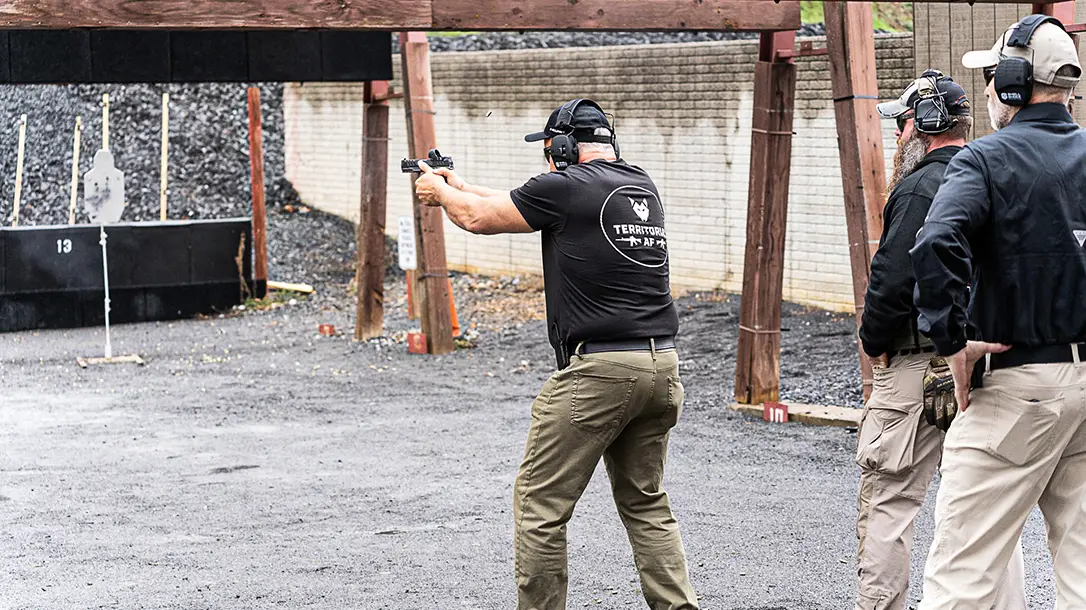Drawing your firearm in the name of self-defense is something that you hope you never have to experience. However, it is still of utmost importance to prepare for. Many factors come into play with an even greater impact on our performance and ultimate outcome than the standard basics of marksmanship could teach us. For this reason, defensive handgun training should be a regular part of your training regimen.

Defensive Handgun Training Prepares the Mind and Body
Understanding the effects on mind and body, when your life’s on the line, goes a long way to ensuring survival. First and foremost, you are going to want to consider your mindset.
Advertisement — Continue Reading Below
What frame of mind are you in when suddenly presented with a life-or-death scenario? Do you freeze with fear? Or do you immediately sense the fragility of your own mortality and the need to defend it?
Courage is not the absence of fear but the will to overcome it. So, the question lies, what can we do to train our minds and bodies for such a scenario?

Advertisement — Continue Reading Below
Point Shooting for Sudden Defensive Scenarios
Bullseye-style shooting goes out the window when taking part in defensive training. Forget about landing every shot in the x-ring or proper sight alignment. Likewise, forget about proper firearm mount and stance.
Your main point of focus is now going to be the threat you have identified, as opposed to the front sight, as you may be used to in traditional everyday target practice. In defensive-style training, you will often hear and utilize the term “point shooting.”
Point shooting essentially utilizes the pointing of your thumbs (with handguns), or pointer finger on your support hand (with long guns), to orient the firearm toward the intended target.
Advertisement — Continue Reading Below
Both eyes should always remain open. Otherwise, you compromise your peripheral vision and risk a threat approaching from the side unseen. Your body should be oriented towards the target, with feet shoulder-width apart and shoulders rolled slightly forward.
Nothing should be done to an extreme as you want to remain balanced should you be bumped or pushed.

Advertisement — Continue Reading Below
Training the Body for the Pressure of Defensive Shooting
Have you ever been in a rush and found yourself fumbling to complete a normally simple task? Imagine that difficulty multiplied tenfold.
When your heart is racing, and adrenaline is surging through your veins, the body begins to react in very interesting ways. Fine motor skills fly out the window—making pushing a magazine release, bolt release, or slide lock difficult.
Gross motor movements become the way to go when it comes to overcoming these difficulties. So, you may find yourself slapping the bolt release on your AR with the base of your palm or flinging loose the magazine during a rushed reload.
Advertisement — Continue Reading Below
Have a malfunction? Keeping your eye on the threat while performing the tap/rack/bang sequence of maneuvers can become seemingly impossible for the individual who does not train under pressure.
Have you ever been so nervous your palms began to sweat? Imagine handling your firearm when everything is damp and slick. What are you going to do if your strong hand becomes injured? How often do you practice shooting weak-handed or even manipulating various mechanisms of your gun with your weak hand, such as the slide lock, magazine release, etc.?
Regardless of shooting style, it is always important to shoot with both eyes open. This is ever so important in a defensive scenario to retain as much of your field of vision as possible.
Advertisement — Continue Reading Below
An adrenaline dump can cause you to experience tunnel vision, making it easy to miss a threat in your peripheral. In addition, knowing that this may occur, it is also important to remember to scan and assess your surroundings during the entire encounter.
Remaining situationally aware can mean the difference between going home alive or in a body bag.

Advertisement — Continue Reading Below
Training the Mind to Deal with a Defensive Shooting
So, knowing some of the things that your body can experience is all good and well. But how do you prepare your mind for the stress of finding yourself in an unsavory situation at some point?
Incorporating stress into your training is an excellent way to prepare. This is where bringing a friend with you to the range comes in quite handy. Train under the pressure of a shot timer and compete with your buddy to have the quickest recorded time on a drill you create.
Start timed drills from various positions, such as seated in a chair, lying on a bench, or sitting on the ground. Increase your heart rate by running a predetermined distance and then see how long it takes you to fill a magazine with ammunition, load the gun, and complete a Mozambique drill on your target.
Advertisement — Continue Reading Below
Even the simplest actions are made extremely difficult when your chest is pounding and you are breathing heavily.
Think of all the various scenarios that could occur as you go through your daily routine, and train accordingly. While training in this manner isn’t exactly the easiest thing to do, you will forever regret not having done so should you find yourself needing to call upon skills that you haven’t prepared for.
When it is all said and done, at the end of the day, you must remember that you are going to get out of your defensive handgun training what you put into it. These skills are perishable and you should practice them on a regular basis.
Push the limits and push yourself to be the best that you can be. Build that solid foundation and develop a skill set that you can fall back on should you be called to do so.























